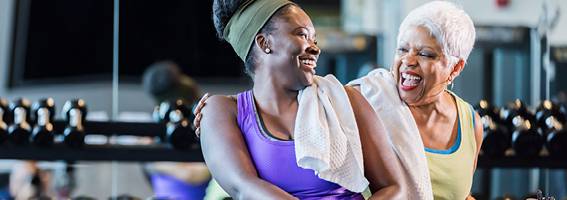When you hear “snacking,” your mind probably thinks of chips, nuts, fruit, and whatever food you tend to reach for when you get hungry between meals. But there is a new kind of snacking on the menu, and it can positively impact your health—exercise snacking.
What is exercise snacking?
Exercise snacking is a relatively new term for an exercise practice that people have been doing for many years. Born from high-intensity interval training (HIIT) and sprint interval training (SIT), exercise snacking takes the idea of short bursts of exercise and rest periods but extends those rest periods.
When you are practicing exercise snacking, you are breaking up your day with short bursts of activity—it is still about the brief moment of exercise, but you are extending the rest period and spreading the exercise throughout the day.
Whether at home, work, or running a few errands, you can have an exercise snack when it works for you instead of working to fit a 60-minute workout into your busy schedule. Instead, you can simply stop what you are doing for a few minutes to have an exercise snack.
The benefits of exercise snacking
While it might be hard to believe that a few short bursts of activity can move the needle, research shows that exercise snacking can make a big difference in your overall health.
A joint study between the University of British Columbia and McMaster University found that exercise snacking was as effective as traditional sprint interval training in improving overall cardiorespiratory fitness.
Exercise snacking—specifically short bouts of walking or bodyweight squats—has increased dietary amino acid utilization for myofibrillar protein synthesis. This means that your body is using up the amino acids in your body to build muscle more efficiently. These short exercise snacks help to improve the efficiency of this process and therefore contribute to building muscle in your body.
The same study looked at the importance of breaking up sedentary time throughout the day. The 24-Hour Movement Guidelines recommends breaking up long periods of sitting as often as possible. Exercise snacking helps by increasing the number of times you get up and move your body throughout the day, which can improve your metabolic outcomes and vascular function—this means you are improving your body’s ability to process food and your heart functions.
One study from the UK looked specifically at older adults and if exercise snacking can help improve muscle function. After a 28-day study, they concluded that a home-based “little and often” exercise snacking program improved leg power and muscle size in adults aged 65 to 80.
How long should an exercise snack be?
Exercise snacks are short—they can be as little as 20 seconds to a few minutes to raise your heart rate during that time. And each “snack” should be separated by 1 to 4 hours.
How many exercise snacks should you have each day?
The more exercise snacks you can add to your day, the better. All studies have shown that any number of snacks is better than nothing. Aim for 3 to 5 exercise snacks daily, but remember to set attainable and appropriate goals for your activity level.
In a study that compared exercise snacks with standard interval training and found they had equal benefit, participants completed three 20 second “snacks” per day.
If you are still determining a suitable number, speak to your healthcare provider for professional advice.
How to get started exercise snacking
The essential part of exercise snacks is getting up, moving your body, and increasing your heart rate.
A great way to know if you’ve succeeded in raising your heart rate is by using the “talk test.” You’ve hit the perfect activity level if you can still answer a short question but not hold an entire conversation.
Don’t expect to break a sweat—you’re only moving your body for 20 seconds to 2 minutes, and that is not enough time to start sweating.
Here are some excellent exercise snacks to get you started. Remember, you can switch it up and change your snack each time or stick to what works best for you—all exercise snacks are good for you!
- Jog in place
- Jumping jacks
- Burpees
- Jump squats
- Lunges
- Lift weights or grab a couple of water bottles and use those as weights
If you are looking to complete these exercises at your desk, you can take the dynamic aspect out of them to make them more office friendly—try body weight squats and lunges, walking in place, and taking the stairs.
And if you are less inclined to get moving when it feels like a typical exercise, try thinking outside of the box:
- Head to your nearest set of stairs and start climbing
- Walk around while you talk on the phone
- Put your favourite song on and dance
Exercise snacking is a great way to increase your active time throughout the day while decreasing your sedentary time. They are quick and easy, you can do them anywhere, and they don’t have to be scheduled in advance. If you’re looking for a way to get active, and improve your overall health without adding more to your already busy schedule, try exercise snacking!
Please always check with a medical professional to ensure these strategies are right for you.


